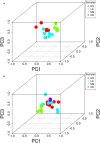Metabolomics approach reveals high energy diet improves the quality and enhances the flavor of black Tibetan sheep meat by altering the composition of rumen microbiota
- PMID: 36034898
- PMCID: PMC9405419
- DOI: 10.3389/fnut.2022.915558
Metabolomics approach reveals high energy diet improves the quality and enhances the flavor of black Tibetan sheep meat by altering the composition of rumen microbiota
Abstract
This study aims to determine the impact of dietary energy levels on rumen microbial composition and its relationship to the quality of Black Tibetan sheep meat by applying metabolomics and Pearson's correlation analyses. For this purpose, UHPLC-QTOF-MS was used to identify the metabolome, whereas 16S rDNA sequencing was used to detect the rumen microbiota. Eventually, we observed that the high energy diet group (HS) improved the carcass quality of Black Tibetan sheep and fat deposition in the longissimus lumborum (LL) compared to the medium energy diet group (MS). However, HS considerably increased the texture, water holding capacity (WHC), and volatile flavor of the LL when compared to that of MS and the low energy diet group (LS). Metabolomics and correlation analyses revealed that dietary energy levels mainly affected the metabolism of carbohydrates and lipids of the LL, which consequently influenced the content of volatile flavor compounds (VOCs) and fats. Furthermore, HS increased the abundance of Quinella, Ruminococcus 2, (Eubacterium) coprostanoligenes, and Succinivibrionaceae UCG-001, all of which participate in the carbohydrate metabolism in rumen and thus influence the metabolite levels (stachyose, isomaltose, etc.) in the LL. Overall, a high-energy diet is desirable for the production of Black Tibetan sheep mutton because it improves the mouthfeel and flavor of meat by altering the composition of rumen microbiota, which influences the metabolism in the LL.
Keywords: black Tibetan sheep; dietary energy levels; meat quality; metabolomics; rumen microbiota.
Copyright © 2022 Zhang, Han, Hou, Raza, Gui, Sun, Wang, Yang, Yuan, Simal-Gandara, El-Shehawi, Alswat, Alenezi, Shukry, Sayed and Aloufi.
Conflict of interest statement
The authors declare that the research was conducted in the absence of any commercial or financial relationships that could be construed as a potential conflict of interest.
Figures







Similar articles
-
Metabolome and microbiome analysis revealed the effect mechanism of different feeding modes on the meat quality of Black Tibetan sheep.Front Microbiol. 2023 Jan 6;13:1076675. doi: 10.3389/fmicb.2022.1076675. eCollection 2022. Front Microbiol. 2023. PMID: 36687606 Free PMC article.
-
Integrated metabolome and microbiome analysis reveals the effect of rumen-protected sulfur-containing amino acids on the meat quality of Tibetan sheep meat.Front Microbiol. 2024 Feb 8;15:1345388. doi: 10.3389/fmicb.2024.1345388. eCollection 2024. Front Microbiol. 2024. PMID: 38389537 Free PMC article.
-
Exploring the effects of palm kernel meal feeding on the meat quality and rumen microorganisms of Qinghai Tibetan sheep.Food Sci Nutr. 2023 Apr 5;11(6):3516-3534. doi: 10.1002/fsn3.3340. eCollection 2023 Jun. Food Sci Nutr. 2023. PMID: 37324863 Free PMC article.
-
Effects of different feeding regimes on muscle metabolism and its association with meat quality of Tibetan sheep.Food Chem. 2022 Apr 16;374:131611. doi: 10.1016/j.foodchem.2021.131611. Epub 2021 Nov 16. Food Chem. 2022. PMID: 34863603
-
Responses of rumen microorganisms and metabolites to different roughage of domesticated Tibetan sheep.Front Microbiol. 2023 Aug 17;14:1247609. doi: 10.3389/fmicb.2023.1247609. eCollection 2023. Front Microbiol. 2023. PMID: 37664115 Free PMC article.
Cited by
-
Effect of Different Heat Treatments on the Quality and Flavor Compounds of Black Tibetan Sheep Meat by HS-GC-IMS Coupled with Multivariate Analysis.Molecules. 2022 Dec 25;28(1):165. doi: 10.3390/molecules28010165. Molecules. 2022. PMID: 36615360 Free PMC article.
-
Insight into the differences of meat quality between Qinghai white Tibetan sheep and black Tibetan sheep from the perspective of metabolomics and rumen microbiota.Food Chem X. 2023 Aug 16;19:100843. doi: 10.1016/j.fochx.2023.100843. eCollection 2023 Oct 30. Food Chem X. 2023. PMID: 37780244 Free PMC article.
-
Effect of Adding Alkaline Metal Ions Complexes Rumen Microbiota and Metabolome of Hu Lambs.Animals (Basel). 2025 Jun 19;15(12):1816. doi: 10.3390/ani15121816. Animals (Basel). 2025. PMID: 40564364 Free PMC article.
-
Integrated Metabolomics and Transcriptomics Analyses Reveal the Candidate Genes Regulating the Meat Quality Change by Castration in Yudong Black Goats (Capra hircus).Genes (Basel). 2023 Dec 27;15(1):43. doi: 10.3390/genes15010043. Genes (Basel). 2023. PMID: 38254933 Free PMC article.
-
Effects of Dietary Energy Levels on Growth Performance, Serum Metabolites, and Meat Quality of Jersey Cattle-Yaks.Foods. 2024 Aug 14;13(16):2527. doi: 10.3390/foods13162527. Foods. 2024. PMID: 39200454 Free PMC article.
References
-
- Papi N, Mostafa-Tehrani A, Amanlou H, Memarian M. Effects of dietary forage-to-concentrate ratios on performance and carcass characteristics of growing fat-tailed lambs. Anim Feed Sci Technol. (2011) 163:93–8. 10.1016/j.anifeedsci.2010.10.010 - DOI
LinkOut - more resources
Full Text Sources

